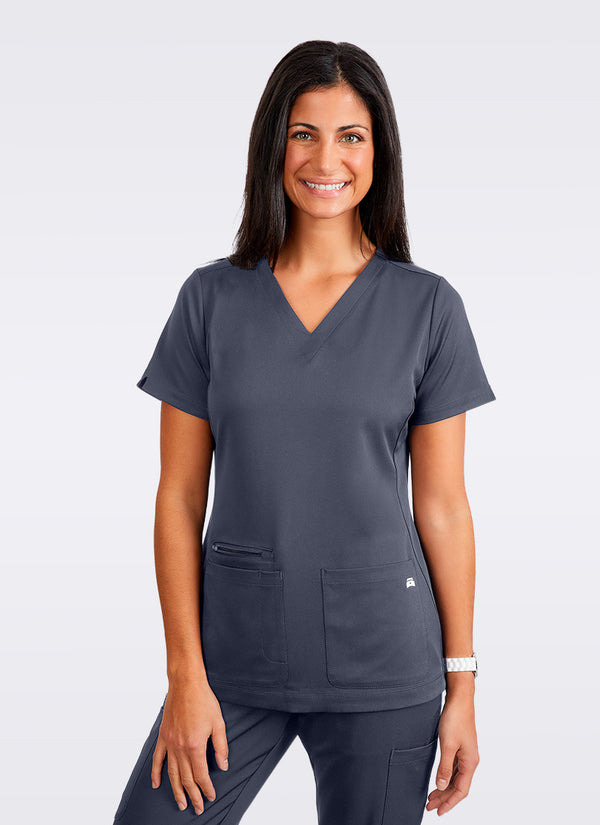Ask a Nurse: What Are the Best Scrubs for Nurses?
 Credit: Wavebreakmedia / Getty Images
Credit: Wavebreakmedia / Getty ImagesIn our Ask a Nurse series, experienced nurses provide an insider look at the nursing profession by answering your questions about nursing careers, degrees, and resources.
Our team independently chose these products. If you click on a product link, we may earn a commission. Learn more here.
Question: What are the best scrubs for nurses?
When you’re working 8-12-hour shifts, it’s important to choose scrubs that are comfortable, highly mobile, and have moisture-wicking fabric. We asked nurses, doctors, and respiratory therapists about the best scrubs for nurses.
They shared their favorite brands, what to look for, and types of scrubs to avoid. Review the factors that are important when looking for scrubs and the brands healthcare professionals recommend.
What to Look For in Nursing Scrubs
1 Comfort
Most nurses are wearing their scrubs for at least 10 hours each day when they work an eight-hour shift. That time can extend to 12-16 hours a day. Clothing worn for long periods of time should be comfortable and durable.
Lisa Malone is the clinical product manager at Axxess, a home healthcare technology company. She believes that comfort is key to finishing your shift without the extra aggravation of picking at your clothing for nearly 12 hours.
“While I know you want to look fashionable, there are definitely options that include both fashion and comfort. And trust me, after a few shifts of constantly moving and wiping things off yourself, you will be way more concerned about how you feel than how you look,” she says.
2 Flexibility and Mobility
Factors that contribute to the comfort of your nursing scrubs are the flexibility and mobility of the fabric. John Landry is a registered respiratory therapist who stresses the importance of being able to move easily throughout your shift.
“Mobility is an important skill for respiratory therapists because we have to respond quickly to patients in need,” he says.
The same factor is necessary for the best scrubs for nurses. They must be ready to respond to a code, bend down to a child’s eye level, and transfer a patient from the bed to the wheelchair all in one shift.
3 Moisture-Wicking Fabric
Nursing is hard work and it’s not unusual to be sweating by the end of the shift. Krista Elkins is a registered nurse and paramedic with 20 years of experience working on ground and helicopter ambulances. She also stresses the need for flexible fabrics and adds they should also be moisture wicking.
“A nurse is going to be in this outfit for 12 hours, and it is important to make sure that the scrubs are soft and that they don’t ride uncomfortably in any particular places, such as the groin or armpits,” she says. “Nice wicking material is also good versus cotton, as nurses sweat a lot!”
4 Neckline
If you look through your closet, you’ll likely find that you favor a certain neckline over others because it looks best on you. While this factor may not be the most important as you’re choosing nursing scrubs, wearing the right neckline for your body type can help you feel and look your best at the end of a long shift.
In most cases, you can choose from a v-neck, round-neck, or square-neck top. It’s most important to choose the one you feel most comfortable with.
5 Pocket Placement
Nurses need pockets. It’s best to have pockets on both the right and left sides of your scrubs. You may be more comfortable with roomy pants pockets or prefer patch pockets on your scrub top. Whichever you choose, be sure they are large enough to carry everything you need.
6 Style
This may not be the most important factor when choosing your nursing scrubs, but wearing clothing you hate can impact your attitude by the end of a shift. Thankfully, some of the best scrubs for nurses are created by designers.
You’ll have choices in the type of fabric and whether it’s plain, printed, or embroidered. There are a number of other style choices, including loose fit or slimming, option of side slits, neckline shape, and color.
Types of Scrubs to Avoid
There are other important factors to consider when you are looking for scrubs that are comfortable, functional, and stylish. Another option that has gained popularity is an antimicrobial infusion in the fabric.
This is supposed to inhibit the growth of pathogens. However, these scrubs are often pricey and research does not support the effectiveness of the product. Another consideration is how low the neckline dips. Bending over can reveal too much to your patients.
Do the bend-over test at home in front of a mirror. Wear a camisole or t-shirt underneath if there is a hint that too much may be revealed.
The Best Nursing Scrubs for Comfort and Functionality
Nursing uniforms have come a long way since all white shoes, tops, pants, and dresses. Today, you have your choice of fabric, prints, styles, and lengths. These are the five best scrubs for nurses ranked by professionals who wear scrubs at work.
FIGS
These stylish, comfortable, and durable scrubs were the favorite of many of our contributors. Although the scrubs are costlier than other brands, they wear well for years. So while the initial investment may be greater, you may save money in the long run.
The company caters to people of all heights and sizes, so you may not have to make any alterations. Lilac and royal blue are the two brightest colors they carry.
Paul Adenuga, MD, current chief resident in plastic and reconstructive surgery at NYU Langone Health, wears FIGS almost exclusively. Landry also wears FIGS, which he says have become increasingly popular with healthcare professionals.
“FIGS scrubs are made of stretchy, moisture-wicking material that makes it easy for me to move throughout the hospital. Their scrubs have a tailored fit that helps me look and feel good while at work,” Landry says.
Medicine Mountain Scrubs
Elkins favors Medicine Mountain Scrubs, which is a small business owned by two sisters in Montana. The company caters exclusively to the needs of women with the motto: “for women, by women.”
The company uses fabric that is woven in North Carolina from recycled plastic bottles with a focus on full coverage. The scrubs are created in small batches with an aim at comfort, style, and functionality.
“All of their products are sustainably sourced. They are the most comfortable scrubs brand I have worn in over a decade. The material is so soft and comfortable,” Elkins says.
Cherokee Brand
Malone prefers Cherokee brand nursing scrubs. “They are a nice thick material but feel lightweight to wear and are comfortable and durable,” she says. “Another great selling point is their low price.”
Cherokee carries men’s, women’s, and unisex scrubs in several different colors and prints. They also carry dresses, skirts, jackets, and vests.
The maternity mock wrap scrub has a drawstring that adjusts from the first to the third trimester. The material has a little extra stretch, and it’s light and breathable.
Moxie Scrubs
This is the first direct-to-consumer brand of medical apparel. The company was birthed from Harvard’s Innovation Lab by New Yorker and Harvard alum, Alicia Tulsee. The brand caters to female nurses and offers a modified v-neck with more coverage than the standard v-neck scrub.
They offer a variety of colors and sizes that range from petite to tall. They carry tops, pants, and jackets made with soft, four-way stretch fabric for comfort all day.
Dickies
The company specializes in work clothing and not just healthcare scrubs. They offer many colors and collections for nurses who are interested in functionality, comfort, and style.
Nurses have several choices in pants and tops, like a tapered leg, cargo pants, and flared leg pants. The company carries men’s, women’s, and unisex clothing styles. The work clothing is designed for people of all heights and body types.
In Summary:
- The best scrubs for nurses are comfortable, moisture wicking, flexible, and stylish.
- Some of the most popular scrub brands are FIGS, Cherokee, and Medicine Mountain Scrubs.
- Consider pocket placement on your scrubs to carry the necessities throughout your shift.
- Although antimicrobial coatings are becoming more popular, the effectiveness of the product is not supported by research.
- While v-neck tops are popular, it is crucial to do the bend-over test in front of a mirror at home to ensure you do not reveal too much to your patients.
Meet Our Contributors

Lisa Malone is a clinical product manager at Axxess, a home healthcare technology company. She works closely with Axxess developers to guide solutions from concept to launch. Before joining Axxess, she served as the director of clinical services at Maxim Healthcare Services, where she led colleagues in providing exceptional care.

John Landry is a registered respiratory therapist from Memphis, Tennessee. He also has a bachelor’s degree in kinesiology. He enjoys using evidence-based research to help others breathe easier and live a healthier life.

Krista Elkins has 20 years of experience in healthcare as both a paramedic and a registered nurse. She has worked on both ground and helicopter ambulances, emergency rooms, intensive care units, primary care, speciality care, psychiatric, and wilderness medicine. She also practices and has a devoted life-long interest in preventative medicine. In addition, she writes content marketing for the healthcare industry.

Paul Adenuga is in his final year of training as a chief resident in plastic and reconstructive surgery at NYU Langone Health. He is also a board-certified general surgeon.
You might be interested in

Ask a Nurse: What Are the Best Nursing Shoes?
A nurse’s choice in shoes can make or break a shift. When comfort is your goal, these may be the best nursing shoes.

Ask a Nurse: Should Nurses Be Diluting IV Push Medications?
Find out why diluting medications run the risk of poor patient outcomes and legal trouble for nurses.

Ask a Nurse: What Can I Do as a High Schooler to Get a Head Start On Becoming a Registered Nurse?
High school students can take these steps to improve their chances of admission into a nursing program and get a head start on their education.




